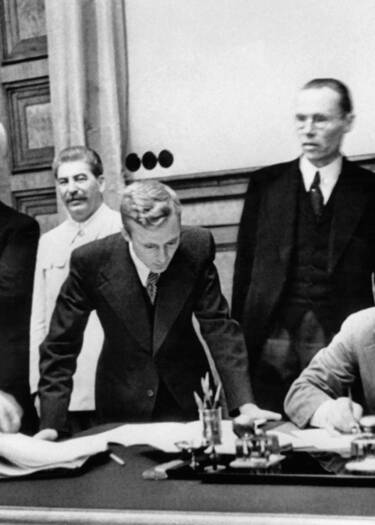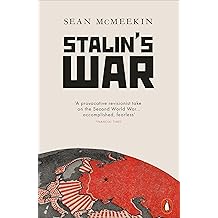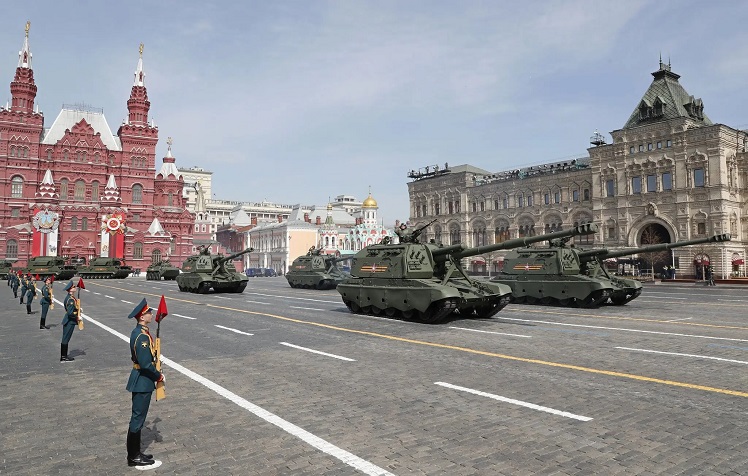
As troops recently returned from Ukraine rolled
through Red Square in armored personnel carriers, Putin justified his
assault on Russia’s neighbor as a response to mounting violence by US-
and NATO-backed fascists.
Thus writes Jeff Jacoby about the May 9 parade, during which Vladimir Putin held a Victory Day speech telling the country's soldiers that among various other things, "You are fighting for the Motherland, for its future, so that no one forgets the lessons of World War Two."
As Antony Beevor notes in his history of The Second World War, "In Soviet eyes the definition of 'fascist' included anyone who did not follow the orders of the Communist Party." Might that not be generalized, in post-communist times (and even perhaps in pre-communist, i.e., in Tsarist, times [although the foreign demonization would in the latter case involve another word than (the post-WWI) "fascist"]?), to "Russian eyes" and to "Russia's ruling party"?
Back to Jeff Jacoby, who begs to differ regarding "the lessons of World War Two":

Just as Putin’s Ukraine narrative is a confection of nonsense — from his repeated insistence that NATO has been engaged in a hostile
attempt to “encircle” Russia to his absurd contention that Ukraine is
not a real nation and has no right to sovereignty — so too is the legend
that Russia was an innocent victim of Adolf Hitler, and that the launch
of World War II was a monstrous crime committed by Germany alone.
There is no denying that a vast number of
Soviet citizens lost their lives in World War II. Without the Russian
people’s appalling suffering and sacrifice, the Allies might not have
triumphed in the end.
But there is also no denying that Moscow
was Nazi Germany’s partner in unleashing the war, the deadliest in human
history, in the first place. Victory Day is a good opportunity to
review the record of Russian culpability in plunging the world into war —
a record the Kremlin’s propagandists have been trying to obscure for
decades.
World War II is commonly said to have started on Sept. 1, 1939
, when German forces invaded Poland.  But it would perhaps be more
accurate to date the start of the war nine days earlier. On Aug. 23,
1939, German Foreign Minister Joachim von Ribbentrop and Soviet Foreign
Minister Vyacheslav Molotov signed a treaty of non-aggression, whereby
their governments agreed to conquer and divide Poland and the rest of
Eastern Europe. It was under the terms of this pact that the Nazi
Wehrmacht moved into western Poland on Sept. 1 and Josef Stalin’s Red
Army invaded Poland from the east 16 days later.
But it would perhaps be more
accurate to date the start of the war nine days earlier. On Aug. 23,
1939, German Foreign Minister Joachim von Ribbentrop and Soviet Foreign
Minister Vyacheslav Molotov signed a treaty of non-aggression, whereby
their governments agreed to conquer and divide Poland and the rest of
Eastern Europe. It was under the terms of this pact that the Nazi
Wehrmacht moved into western Poland on Sept. 1 and Josef Stalin’s Red
Army invaded Poland from the east 16 days later.
“Soviet and German forces set up brutal
occupation regimes in their respective spheres and forcibly transferred
hundreds of thousands of Polish citizens to forced-labor sites,” recounts Mark Kramer, the director of the Cold War Studies Project at Harvard’s Davis Center for Russian and Eurasian Studies
… Devouring
half of Poland didn’t slake Moscow’s appetite. In the months that
followed the Nazi-Soviet takeover of Poland, as Hitler’s troops
conquered Denmark, Norway, Belgium, Holland, and France and bombed much
of London into rubble, Stalin’s forces continued their illegal war of aggression and conquest. Writes Kramer:
Even as the Red Army was imposing Soviet
rule on eastern Poland, Soviet troops also began moving into the three
Baltic states (Estonia, Latvia, Lithuania), which had enjoyed some two
decades of independence after the First World War. In subsequent months,
as Soviet military and state security forces continued to pour into the
Baltic countries, they compelled the local governments to comply with
Moscow’s demands. Eventually, in mid-1940, Soviet occupying forces
replaced the indigenous governments with puppet regimes that voted for
“voluntary” incorporation into the USSR. The same pattern was evident in
the formerly Romanian territories of
Bessarabia and northern Bukovina, which the Soviet Union occupied and
annexed in late June 1940.
The only major impediment to the
expansion of Soviet rule in Eastern Europe came in Finland, where the
entry of Soviet troops at the end of November 1939 sparked a brief but
intense war.
In short, for the first two
years of World War II, Nazi Germany and Soviet Russia were allies. They
secretly planned and jointly began the war that inflicted such horror
and destruction. Later, of course, Hitler double-crossed Stalin and
ordered the Wehrmacht to invade the Soviet Union in June 1941. But
before that turning point, the two totalitarian powers cooperated
closely. …
Armored vehicles rolled through Red Square in Moscow during a rehearsal for today's Victory Day military parade.
In
2014, Putin made it a crime for Russians to “spread intentionally false
information” — i.e., to tell the truth — about the atrocities committed
by Soviet forces during World War II. As a result, writes Kramer, “the
brutality of the Soviet occupation of eastern Poland, including
massacres and widespread rapes, is a taboo subject in Russia nowadays.”
In much the same way, Putin has made it illegal
for Russian journalists today to report on Moscow’s massive violations of human-rights crimes in Ukraine.
In his Victory Day remarks, Russia’s
dictator linked the record of the Red Army in the 1940s with that of the
Russian troops now fighting in Ukraine. There are indeed parallels
between the two, though decidedly not the ones Putin wants the world to
focus on.
From 1939 through mid-1941, Soviet Russia
collaborated with the Nazis in wreaking slaughter and savagery on the
nations of Europe. The regime that rules in Moscow today is of course
not responsible for Stalin’s evil alliance with Hitler. But no one
should be fooled as Putin seeks to cloak himself and his calamitous
Ukraine war in the “heroic” history of World War II-era Russia. Moscow
and Berlin together started that horrific war, and used it to impose a
reign of tyranny across Europe. Germany no longer terrorizes its
neighbors. Russia still does.
“Soviet and German forces set up brutal
occupation regimes in their respective spheres and forcibly transferred
hundreds of thousands of Polish citizens to forced-labor sites,” recounts Mark Kramer, the director of the Cold War Studies Project at Harvard’s Davis Center for Russian and Eurasian Studies.
As is pointed out in a special Stalin's Final Secrets issue of the Géo magazine, Molotov denied the existence of a special protocol in the non-aggression pact until his 1986 death, and the truth did not surface until after the end of the Soviet empire in 1991. Most infamously, the special protocol allowed the Führer and the Vozhd to carve Europe into zones of influence making it, as Balthazar Gibiat calls it, a sort of pre-Yalta Yalta agreement (albeit one formed of course in peacetime, not during a war, i.e., the very war that the special protocol directly led to).
Update: Spasiba, Tovarich Driscoll, who wrote about the same topic eight years ago…
Update 2: This brings up the so-called "paranoid" "witch hunts" against communists in post-war America. Here is a question that is seldom brought up: Who was head of the Kremlin when the term "McCarthyism" was coined? A fellow by the name of Stalin. As for the House Un-American Activities Committee (HUAC), another question is, how many people are aware that the maligned council was not solely involved with communists? Indeed, it was formed the year prior to the Nazi/Soviet non-aggression treaty, in 1938, to investigate disloyalty by subversive organizations tied to either pro-Soviet communists or — yes — pro-German fascists?
Update 3: You know how Democrats and their left-leaning allies abroad always seem to be in the process of aiding America's enemies — and not just aiding them but providing them with the most generous of gifts — from the Ayatollahs' Iran to communist China? Well, it may sound depressing to learn that there is a "groundbreaking reassessment of the Second World War" — aka a “war of necessity” and the “good war” — which states that basically FDR and even Winston Churchill might belong to that very same group. In Stalin's War (A New History of World War II), we are told by Sean McMeekin that
World War II endures in the popular imagination as a heroic struggle
between good and evil, with villainous Hitler driving its events. But
Hitler was not in power when the conflict erupted in Asia—and he was
certainly dead before it ended. His armies did not fight in multiple
theaters, his empire did not span the Eurasian continent, and he did not
inherit any of the spoils of war. That central role belonged to Joseph
Stalin. The Second World War was not Hitler’s war; it was Stalin’s war.
… Hitler’s genocidal ambition may have helped unleash Armageddon,
but as McMeekin shows, the war which emerged in Europe  in September 1939
was the one Stalin wanted, not Hitler. So, too, did the Pacific war of
1941–1945 fulfill Stalin’s goal of unleashing a devastating war of
attrition between Japan and the “Anglo-Saxon” capitalist powers he
viewed as his ultimate adversary.
in September 1939
was the one Stalin wanted, not Hitler. So, too, did the Pacific war of
1941–1945 fulfill Stalin’s goal of unleashing a devastating war of
attrition between Japan and the “Anglo-Saxon” capitalist powers he
viewed as his ultimate adversary.
McMeekin also reveals the
extent to which Soviet Communism was rescued by the US and Britain’s
self-defeating strategic moves, beginning with Lend-Lease aid, as
American and British supply boards agreed almost blindly to every Soviet
demand. Stalin’s war machine, McMeekin shows, was substantially reliant
on American materiél from warplanes, tanks, trucks, jeeps, motorcycles,
fuel, ammunition, and explosives, to industrial inputs and technology
transfer, to the foodstuffs which fed the Red Army.
This
unreciprocated American generosity gave Stalin’s armies the mobile
striking power to conquer most of Eurasia, from Berlin to Beijing, for
Communism.
From the British edition:
With Hitler dead and the Third Reich in ruins, Stalin created an
immense new Communist empire. Among his holdings were Czechoslovakia and
Poland, the fates of which had first set the West against the Nazis
and, of course, China and North Korea, the ramifications of which we
still live with today.
Until Barbarossa wrought a public relations miracle, turning him into a
plucky ally of the West, Stalin had murdered millions, subverted every
norm of international behaviour, invaded as many countries  as Hitler
had, and taken great swathes of territory he would continue to keep. In
the larger sense the global conflict grew out of not only German and
Japanese aggression but Stalin's manoeuvrings, orchestrated to provoke
wars of attrition between the capitalist powers in Europe and in Asia.
Throughout the war Stalin chose to do only what would benefit his own
regime, not even aiding in the effort against Japan until the conflict's
last weeks. Above all, Stalin's War uncovers the shocking details of
how the US government (to the detriment of itself and its other allies)
fuelled Stalin's war machine, blindly agreeing to every Soviet demand,
right down to agents supplying details of the atomic bomb.
as Hitler
had, and taken great swathes of territory he would continue to keep. In
the larger sense the global conflict grew out of not only German and
Japanese aggression but Stalin's manoeuvrings, orchestrated to provoke
wars of attrition between the capitalist powers in Europe and in Asia.
Throughout the war Stalin chose to do only what would benefit his own
regime, not even aiding in the effort against Japan until the conflict's
last weeks. Above all, Stalin's War uncovers the shocking details of
how the US government (to the detriment of itself and its other allies)
fuelled Stalin's war machine, blindly agreeing to every Soviet demand,
right down to agents supplying details of the atomic bomb.









